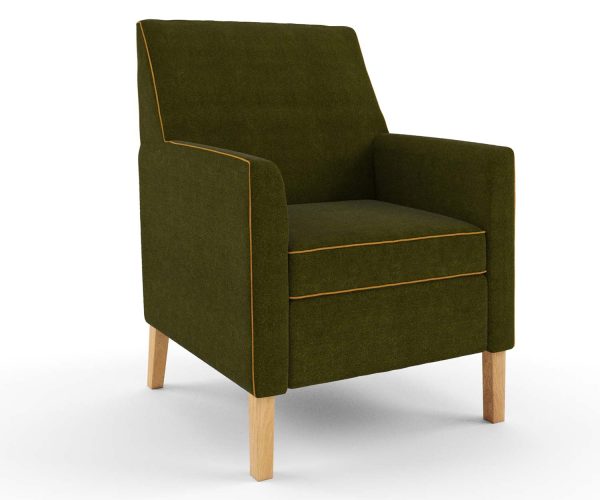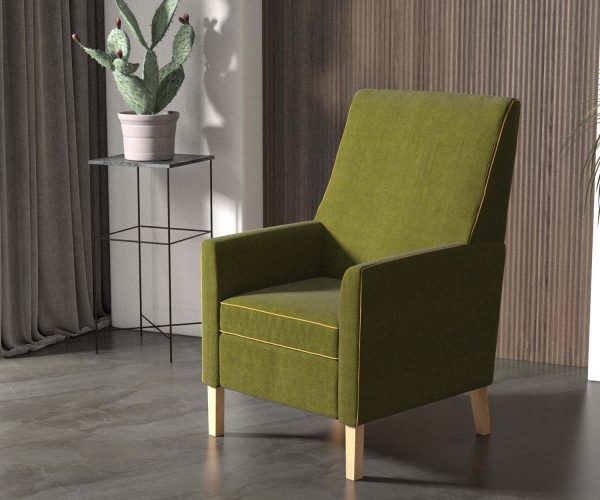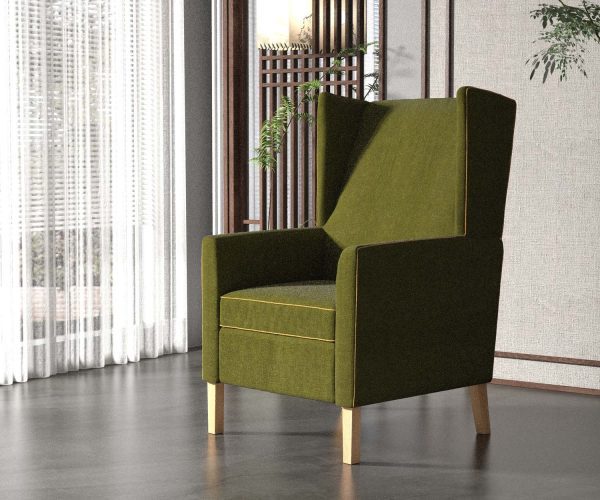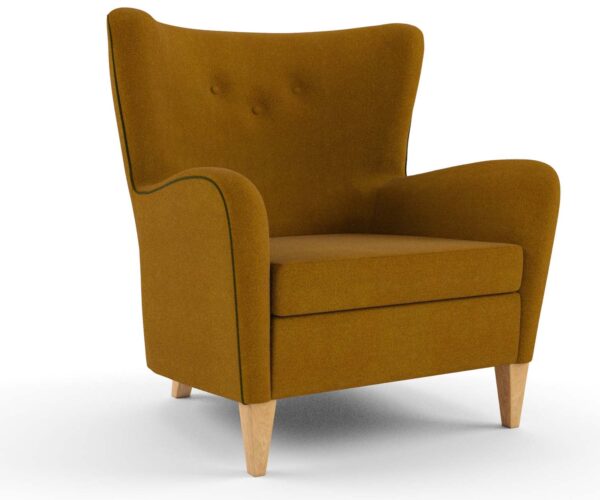Why Seat Height is Important When Choosing Armchairs for Aged Care Residents

Why is Seat Height So Important When Choosing Armchairs for Aged Care Residents?
Selecting the right armchairs for aged care residents in Australia is essential for promoting health, independence, and comfort. Well-designed seating has wide-reaching benefits for elderly people living in aged care facilities.
Benefits of Fit-for-Purpose Armchairs
For older Australians with reduced mobility, armchairs that are fit-for-purpose offer several key advantages:
- Improved Mobility and Independence: Residents can easily sit down and stand up without needing help, promoting self-sufficiency.
- Enhanced Posture and Comfort: Proper seating encourages good posture, reducing pain, fatigue, and the risk of pressure sores or venous thrombosis.
- Encouraged Social Interaction: Comfortable seating encourages residents to be more sociable, which can lead to better food and drink intake.
Conversely, poorly designed armchairs can increase reliance on others and create discomfort, potentially worsening behavioural issues, especially in those with cognitive impairments.
The Importance of Sit-to-Stand Transfers for Aged Care Residents
One critical factor in armchair design is seat height, which directly affects the ease of sit-to-stand transfers—an essential function for maintaining independence.
What is Sit-to-Stand Transfer?
Sit-to-stand transfer, or “chair-rise,” refers to the act of standing up from a seated position. It’s one of the most frequent movements performed throughout the day and is a key indicator of physical function for elderly individuals.
Why is Sit-to-Stand Transfer Difficult for Elderly Australians?
Up to 50% of elderly Australians experience difficulty standing up from an armchair. This movement requires significant motor control, coordination, and momentum. Factors like balance issues, arthritis, and hip or knee pain can make this task even more challenging. Without proper support, sit-to-stand transfers can increase the risk of falls.
How Appropriate Armchair Seat Height Eases Sit-to-Stand Transfers
A higher seat height reduces the effort needed to stand up by minimising the movement required and reducing strain on the hips and knees. This is especially beneficial for elderly people with limited mobility due to conditions like arthritis or recent surgery. Additionally, higher seats help distribute pressure more evenly along the thighs, reducing discomfort and pressure on the pelvis.
The Caveat of Higher Seat Heights
While higher seats can ease sit-to-stand transfers, they may not suit everyone. If the seat is too high, some individuals might not be able to touch the floor with their feet, leading to instability and increasing the risk of venous thrombosis. Although footrests might seem like a solution, they are impractical in aged care facilities as they could become trip hazards.
Additional Factors to Consider for Sit-to-Stand Transfers
Beyond seat height, other factors also influence the ease of sit-to-stand transfers:
- Seat Size: The seat should provide enough space for comfort without being too large, which could make standing up harder.
- Space Underneath the Seat: Clear space under the seat allows residents to position their feet properly for balance and stability.
- Seat and Backrest Angle: The right angle supports posture and helps with transitioning from sitting to standing.
- Armrests: Armrests should be easy to grip and extend to the seat’s edge, providing necessary support. Research shows that when armrests are available, they are used 100% of the time to aid in standing up.
Fit-for-Purpose Armchairs Promote Independence
Equitable design in aged care means providing armchairs that meet the needs of residents, enabling them to move comfortably and safely. Thoughtfully designed armchairs with the right seat height, depth, and armrests go a long way in promoting independence and comfort for older Australians.
With the proper attention to design, aged care facilities can ensure that their furniture meets the functional needs of residents, helping them maintain their dignity and autonomy.
FAQs for Choosing Armchairs for Aged Care Residents
Why is it crucial to choose well-designed armchairs for aged care residents?
Well-designed armchairs significantly impact the health, independence, and comfort of elderly individuals in aged care facilities.
How does seat height contribute to the design of armchairs for the elderly?
Seat height is crucial as it influences the ease with which aged care residents can transition from a seated to a standing position, addressing biomechanical challenges.
What role do footrests play in armchair design for the elderly?
Footrests may be considered in office settings but are generally not feasible in aged care facilities to avoid becoming a potential trip hazard.
Why is the balance between seat height, depth, and armrests important?
Achieving the right balance contributes to the comfort and ease of use of chairs for a larger portion of the aged care population.
Are there specific characteristics of armchair design besides seat height that should be considered?
Yes, other crucial factors include seat size, the space underneath the seat, the angle of the seat and backrest, and the presence of armrests.
How do poorly designed armchairs impact elderly residents with cognitive impairments?
Poorly designed armchairs can cause discomfort, leading to increased frustration and exacerbating behavioral issues in elderly residents with cognitive impairments.
Is customization an option when choosing armchairs for aged care residents?
Many manufacturers offer customization options to tailor armchair features, size, and upholstery to the specific needs and preferences of aged care residents.
How does the angle of the seat and backrest impact the comfort of armchairs for the elderly?
The angle influences the sitting posture and comfort, playing a role in addressing the unique needs of aged care residents.
Can choosing the right armchair positively impact the overall well-being of aged care residents?
Yes, by providing increased comfort, independence, and mobility, well-designed armchairs can positively impact the overall well-being and quality of life for elderly residents in aged care.
Fit-for-purpose armchairs – designed to assist aged care residents to stand from a seated position
More News
Why Seat Height is Important When Choosing Armchairs for Aged Care Residents

Why is Seat Height So Important When Choosing Armchairs for Aged Care Residents?
Selecting the right armchairs for aged care residents in Australia is essential for promoting health, independence, and comfort. Well-designed seating has wide-reaching benefits for elderly people living in aged care facilities.
Benefits of Fit-for-Purpose Armchairs
For older Australians with reduced mobility, armchairs that are fit-for-purpose offer several key advantages:
- Improved Mobility and Independence: Residents can easily sit down and stand up without needing help, promoting self-sufficiency.
- Enhanced Posture and Comfort: Proper seating encourages good posture, reducing pain, fatigue, and the risk of pressure sores or venous thrombosis.
- Encouraged Social Interaction: Comfortable seating encourages residents to be more sociable, which can lead to better food and drink intake.
Conversely, poorly designed armchairs can increase reliance on others and create discomfort, potentially worsening behavioural issues, especially in those with cognitive impairments.
The Importance of Sit-to-Stand Transfers for Aged Care Residents
One critical factor in armchair design is seat height, which directly affects the ease of sit-to-stand transfers—an essential function for maintaining independence.
What is Sit-to-Stand Transfer?
Sit-to-stand transfer, or “chair-rise,” refers to the act of standing up from a seated position. It’s one of the most frequent movements performed throughout the day and is a key indicator of physical function for elderly individuals.
Why is Sit-to-Stand Transfer Difficult for Elderly Australians?
Up to 50% of elderly Australians experience difficulty standing up from an armchair. This movement requires significant motor control, coordination, and momentum. Factors like balance issues, arthritis, and hip or knee pain can make this task even more challenging. Without proper support, sit-to-stand transfers can increase the risk of falls.
How Appropriate Armchair Seat Height Eases Sit-to-Stand Transfers
A higher seat height reduces the effort needed to stand up by minimising the movement required and reducing strain on the hips and knees. This is especially beneficial for elderly people with limited mobility due to conditions like arthritis or recent surgery. Additionally, higher seats help distribute pressure more evenly along the thighs, reducing discomfort and pressure on the pelvis.
The Caveat of Higher Seat Heights
While higher seats can ease sit-to-stand transfers, they may not suit everyone. If the seat is too high, some individuals might not be able to touch the floor with their feet, leading to instability and increasing the risk of venous thrombosis. Although footrests might seem like a solution, they are impractical in aged care facilities as they could become trip hazards.
Additional Factors to Consider for Sit-to-Stand Transfers
Beyond seat height, other factors also influence the ease of sit-to-stand transfers:
- Seat Size: The seat should provide enough space for comfort without being too large, which could make standing up harder.
- Space Underneath the Seat: Clear space under the seat allows residents to position their feet properly for balance and stability.
- Seat and Backrest Angle: The right angle supports posture and helps with transitioning from sitting to standing.
- Armrests: Armrests should be easy to grip and extend to the seat’s edge, providing necessary support. Research shows that when armrests are available, they are used 100% of the time to aid in standing up.
Fit-for-Purpose Armchairs Promote Independence
Equitable design in aged care means providing armchairs that meet the needs of residents, enabling them to move comfortably and safely. Thoughtfully designed armchairs with the right seat height, depth, and armrests go a long way in promoting independence and comfort for older Australians.
With the proper attention to design, aged care facilities can ensure that their furniture meets the functional needs of residents, helping them maintain their dignity and autonomy.
FAQs for Choosing Armchairs for Aged Care Residents
Why is it crucial to choose well-designed armchairs for aged care residents?
Well-designed armchairs significantly impact the health, independence, and comfort of elderly individuals in aged care facilities.
How does seat height contribute to the design of armchairs for the elderly?
Seat height is crucial as it influences the ease with which aged care residents can transition from a seated to a standing position, addressing biomechanical challenges.
What role do footrests play in armchair design for the elderly?
Footrests may be considered in office settings but are generally not feasible in aged care facilities to avoid becoming a potential trip hazard.
Why is the balance between seat height, depth, and armrests important?
Achieving the right balance contributes to the comfort and ease of use of chairs for a larger portion of the aged care population.
Are there specific characteristics of armchair design besides seat height that should be considered?
Yes, other crucial factors include seat size, the space underneath the seat, the angle of the seat and backrest, and the presence of armrests.
How do poorly designed armchairs impact elderly residents with cognitive impairments?
Poorly designed armchairs can cause discomfort, leading to increased frustration and exacerbating behavioral issues in elderly residents with cognitive impairments.
Is customization an option when choosing armchairs for aged care residents?
Many manufacturers offer customization options to tailor armchair features, size, and upholstery to the specific needs and preferences of aged care residents.
How does the angle of the seat and backrest impact the comfort of armchairs for the elderly?
The angle influences the sitting posture and comfort, playing a role in addressing the unique needs of aged care residents.
Can choosing the right armchair positively impact the overall well-being of aged care residents?
Yes, by providing increased comfort, independence, and mobility, well-designed armchairs can positively impact the overall well-being and quality of life for elderly residents in aged care.
Fit-for-purpose armchairs – designed to assist aged care residents to stand from a seated position
Commercial furniture by room
Based in Brisbane, we’re an Australian manufacturer of aged care furniture, retirement living furniture, hospital & healthcare furniture, hotel & accommodation furniture and student accommodation furniture. We also supply a range of commercial office furniture.
Discover the FHG Look Book: Your Source of Inspiration for Quality Australian-Made Commercial Furniture
- Quality Craftsmanship: See why we’ve been a trusted partner for over 25 years.
- Local Excellence: Learn how our Brisbane team ensures the highest standards.
- Inspiration and Ideas: Find innovative furniture solutions for any environment.
Don’t miss the opportunity to transform your commercial space with FHG’s expertly crafted furniture. Download the FHG Look Book today and start your journey towards exceptional design and quality.
























